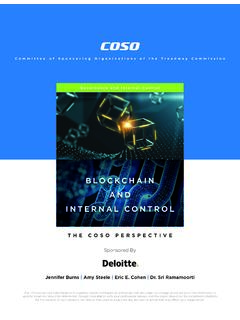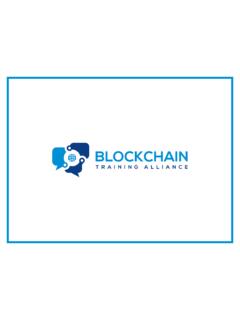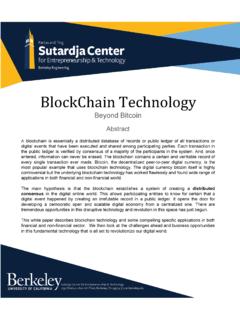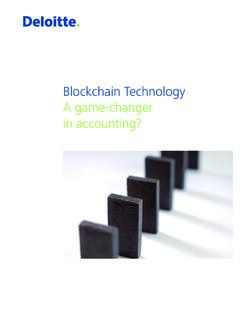Transcription of OECD Blockchain Primer
1 OECD Blockchain POLICY FORUMOECDBLOCKCHAINPOLICYFORUMOECD Blockchain POLICY FORUMOECDBLOCKCHAINPOLICYFORUMOECD Blockchain PrimerThe OECD Blockchain PrimerThis Primer provides an introduction to Blockchain technology, outlines some of the potential benefits it can bring, and considers the risks and challenges it poses. While not comprehensive, it is an overview of the key concepts and terms intended to help people better understand this emerging technology and its growing impact. Blockchain has the potential to transform the functioning of a wide range of industries. Its features can increase the transparency and traceability of goods, data and financial assets, facilitate market access and improve the efficiency of transactions. Fulfilling Blockchain s potential, however, depends on a policy environment that allows innovation and experimentation, while balancing the risks of misuse.
2 Governments will play a significant role in shaping policy and regulatory frameworks that help address challenges presented by the technology, and foster transparent, fair and stable markets as Blockchain , Blockchain is a combination of already existing technologies that together can create networks that secure trust between people or parties who otherwise have no reason to trust one another. Specifically, it utilises distributed ledger technology (DLT) to store information verified by cryptography among a group of users, which is agreed through a pre-defined network protocol, often without the control of a central authority. The marriage of these technologies gives Blockchain networks key characteristics that can remove the need for trust, and therefore enable a secure transfer of value and data directly between parties.
3 Due to this unique ability, Blockchain technology can diminish the role of intermediaries, who can command market power, collect significant fees, slow economic activity, and are not necessarily trustworthy or altruistic keepers of personal information. Although mostly known for its digital financial asset applications (like Bitcoin), Blockchain technology is poised to have an impact on a wide range of sectors. The OECD is exploring the policy implications in a variety of areas including health, transportation, agriculture, environment, and supply chain technology? A currency? The new internet?A Blockchain is a shared ledger of transactions between parties in a network, not controlled by a single central authority. You can think of a ledger like a record book: it records and stores all transactions between users in chronological order.
4 Instead of one authority controlling this ledger (like a bank), an identical copy of the ledger is held by all users on the network, called nodes. NODEA node is simply a computer onthe Blockchain network that storesthe copies of one document are spreadamong users and they are constantly and automatically synchronised, hence identicalat all ledger is a list of all the transactions made on the Blockchain . Technically, it is made up of a chain of each block:HashPrevious block s hashTransaction dataTimestamp A block is comprised of a group of transactions from the same time period, like a page from a record with its own hash, each block stores the hash of the block before hash is a unique string of letters and numbers created from text using a mathematical formula. Blocks are therefore chained together making the ledger (almost) immutable or unable to bechanged.
5 To add a block, it may first need to be mined and then approved by a number of notes through a consensus Blockchain in practiceSource: Savjee, (2017)Hash: 1Z8F Hash: 6BQ1 Hash: 3H4 QPrevious hash: 0000 Previous hash: 1Z8F Previous hash: 6BQ1 Hash: 1Z8F Hash: 6BQ1 H62Y Hash: 3H4 QPrevious hash: 0000 Previous hash: 1Z8F Previous hash: 6BQ1 BLOCKCHAINUNDER THE HOODWhat is Blockchain ?Table 1. The main types of Blockchain segmented by permission modelREADWRITECOMMITEXAMPLEBLOCKCHAIN TYPESOPENP ublic permissionlessOpen to anyoneAnyoneAnyoneBitcoin, EthereumPublic permissionedOpen to anyoneAuthorised participantsAll or subset of authorised participantsSupply chain ledger for retail brand viewable by publicCLOSEDC onsortiumRestricted to an authorised set of participantsAuthorised participantsAll or subset of authorised participantsMultiple banks operating a shared ledgerPrivate permissioned enterprise Fully private or restricted to a limited set of authorised nodesNetwork operator onlyNetwork operator onlyExternal bank ledger shared between parent company and subsidiariesSource.
6 Hileman & Rauchs, 2017 Before going further, it is important to note that not every Blockchain is made the same. While there are a number of variable features, two of the most important are the openness of the platform (public or private) and the level of permissions required to add information to the Blockchain (permissioned or permissionless). Public blockchains (like Bitcoin) are open for anyone to read and view, while private blockchains can only be viewed by a chosen group of people. Similarly, permissioned blockchains permit just a select group of users to write ( generate transactions for the ledger to record) and commit ( verify new blocks for addition to the chain). In contrast, permissionless blockchains allow anyone to contribute and add data to the LAYERNETWORKING LAYERPROTOCOL LAYERThe application layer is where networks and protocol areused to build applications that users interact protocol layer lays the foundational structure of the Blockchain .
7 It determines the computing language the Blockchain will be coded in and any computational rulesthat will be used on the Blockchain . The networking layer is where the rules set up on theprotocol layer are actually is comprised of three layers that each add differentcomponents to its development. It is not necessary to get involved in the most technical layers in order to develop an application or use a Blockchain layers of Blockchain Source: Demirors, 2017 Different types of blockchainDistributedOne of the core aspects of a Blockchain is that it is a distributed ledger, meaning that the database is maintained and held by all nodes in the network. No central authority holds or updates the ledger, rather each node independently constructs its own record by processing every block (group of transactions), deciding if it is valid, then voting via the consensus mechanism on their conclusions.
8 Once a change in the record is agreed, each node updates its own ledger. In contrast, traditional databases are stored and maintained centrally, which can make them high-value targets for hackers and criminals. ImmutableIn general, once a transaction is added to a Blockchain ledger, it cannot be undone. This immutability is one of the principal aspects that contribute to the trustworthiness of Blockchain transactions. A Blockchain s immutability is secured through its use of cryptography (see below for an explanation of hashing). In a traditional, centralised database, an authorised user can connect to the server to add or modify the data without the approval or detection of other users. Because all the data is held in one place, if the security of the server or the authority that runs the server is compromised, data can be modified or permanently deleted.
9 This may sometimes be irreversible and occur without anyone else realising by consensusNo block can be added to the ledger without approval from specified nodes in the network. Rules regarding how this consent is collected are called consensus mechanisms. Consensus protocols are crucial in ensuring that every block is valid and that all participants agree and maintain the same version of the ledger. They heavily affect the incentives for nodes to act honestly and are therefore the most important variables when designing a Blockchain . Misconceptions about blockchainPseudonymous Contrary to popular belief, in general, Blockchain technology does not allow its users to be totally anonymous. Rather, public Blockchain platforms tend to be pseudonymous: user identities can be anonymous but their accounts are not, as all of their transactions are visible to all other users.
10 On these platforms, user accounts can be created without any identification or authorisation process. This allows users to use a pseudonym. Permissioned blockchains can require a user s identity to be verified before they are able to access or use the almost rare, it is possible for the Blockchain to be compromised if nodes pool their resources and collude to approve incorrect ledger entries. However, the larger the network, the more difficult it becomes to carry out this attack. In most systems, it would cost the attacker many more resources to carry out the attack than they would gain from the attack itself. Additionally, some private blockchains allow for central authority nodes to change information on the ledger. Advances in quantum computing (supercomputing) threaten some current cryptographic security measures, but there is equally the likelihood that Blockchain s security will evolve with quantum computing s key characteristicsExamples of hashesInput Hash output (using SHA 256 algorithm)OECD 879D5 ACDCDA51A6F1B00 EBFE77513D9B19F574499C867997EE1FB6B1FA6 DDBB0 OeCD19C91C8433AC66422E8B13A468B3E96D5D79 24 BEB1164F8412484900C7C1 EDC6 Note: Even subtle changes like upper or lower case significantly alter the some blockchains, in order to add blocks to the ledger, transfers must go through a mining process.

















